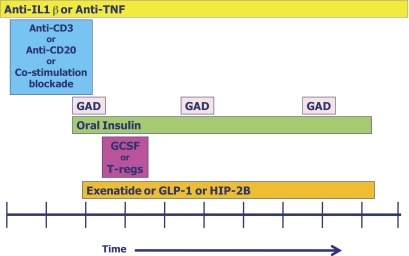FIG. 4.
Potential scheme for combination therapy to interdict the type 1 diabetes disease process. Such a combination might include an anti-inflammatory therapy (e.g., anti–interleukin-1β [anti-IL1β] or anti-tumor necrosis factor [anti-TNF]), an immunomodulatory therapy (e.g., anti-CD3, anti-CD20, or co-stimulatory blockade), followed by initiation of antigen-specific therapy (e.g., GAD and/or oral insulin), with stimulation of protective immunity (e.g., with granulocyte colony stimulation factor [GCSF]) or provision of protective immunity by infusion of T-regulatory (T-reg) cells, and with stimulation of β-cells (e.g., with glucagon-like peptide 1 [GLP-1], exenatide, or human proislet peptide-2B [HIP-2B]). The time frame needs to be determined, so the x-axis is dimensionless.

